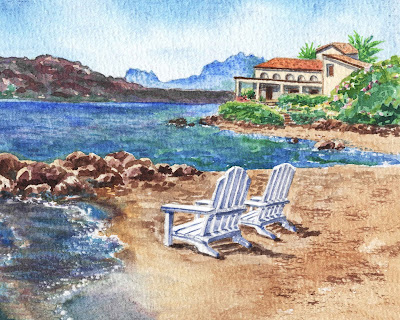Venice Italy Burano And Murano Islands Watercolor Paintings
Today I want to invite my Art followers to Italy. As I've been there several times, so I've painted Italy several times and then more. These two watercolor paintings of Murano and Burano islands are very special to me. I painted them in the spirit of virtual travel this year, for my Around The World Series , which one by now has dozens of World Wonders all around the globe.
Murano island was initially settled by the Romans and from the sixth century by people from Altinum and Oderzo. At first, the island prospered as a fishing port and through its production of salt. It was also a center for trade through the port it controlled on Sant ‘Erasmo. Murano island is located in the north of Venice, in Veneto region, northeastern Italy, with an area of 1,134 acres and it experienced its major development after 1291, when glass furnaces were moved there from Venice. Murano became the manufacturing center for Venetian glass, exported in large quantities to all of Europe. It reached its high point in the 16th century, when it had more than 30,000 inhabitants; glassmaking continues but on a considerably reduced scale. A record of this aspect of Murano’s history is found in the Museum of Glass Art in the Giustinian Palace. The most important building in Murano is the basilica of Saints Maria e Donato. In its present state it dates from the 13th century, having been rebuilt several times since its founding in the 7th century. The church that I’ve painted in my artwork is San Pietro Martire, it was founded in the 14th century and it contains paintings by Giovanni Bellini, Paolo Veronese, and Tintoretto.
Burano island, is in northeastern suburb of Venice, includes four islets in the Laguna Veneta. The settlement is thought to have been founded in the 5th century by refugees from nearby Altino, fleeing in the path of Attila. The 16th-century church of S. Martino has paintings by Giovanni Battista Tiepolo. In the 16th century, lacemaking was fostered there, and Venetian point laces, especially the lace known as Punto di Burano, were produced until the late 18th century, when the industry died out. A lacemaking school was founded in 1872 to revive the industry and to combat local poverty, and Burano is now one of the last surviving centers of hand lacemaking. Fishing is also an important economic factor there. I loved painting famous colorful buildings and cafes of Burano island. For me it was like coming into the playground where all the kids are established artists, but they feel and act like kids, pouring different colors on their palettes.
Grand thanks to the International Art Collector from Uppsala, Sweden, for purchasing this artwork:
Read more in the article HERE
Many thanks to the Art Collector from BRYN MAWR, PA for purchasing print of this artwork:
Read more in the article HERE
Read more in the article HERE
Grand thanks to the Art Collector from Stewartsville, NJ for purchasing a print with this artwork:
Read more in the article HERE
My appreciation goes to the Art Collector from Richmond, VA for purchasing a nice canvas print with this Monet House in Giverny France watercolor:
Read more in the article HERE
Many many thanks to the Art Collector from Midland, GA for purchasing print with this artwork:
To read the article about this painting go HERE
As an artist I present more than five thousand paintings in different galleries on my website.
And as a watercolor artist illustrator I have an extensive and I can now say quite impressive Artist Portfolio HERE
Live To Create!!!









